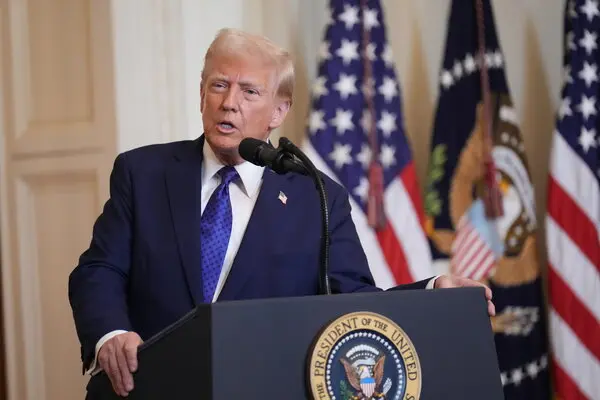Islamabad, April 02: U.S. President Donald Trump is preparing to introduce a broad set of reciprocal tariffs on major global trading partners this Wednesday, marking a significant shift away from decades of rules-based trade agreements.
The move is expected to increase costs for businesses and consumers while provoking retaliation from affected nations.
Details of the initiative, dubbed “Liberation Day” tariffs, remain under wraps ahead of a White House Rose Garden announcement scheduled for 4 p.m. Eastern Time (2000 GMT).
According to White House spokesperson Karoline Leavitt, the tariffs will take immediate effect once Trump unveils them, while a 25% global duty on auto imports is set to commence on April 3.
For weeks, Trump has argued that these tariffs are meant to level the playing field, addressing what he views as disproportionately high tariffs and non-tariff barriers imposed by other countries on American exports.
However, the exact structure of the new duties remains uncertain, with reports suggesting Trump is considering a 20% universal tariff.
A former senior trade official from Trump’s first term told Reuters that rather than a blanket tariff, the administration is more likely to impose individualized tariffs on different nations, potentially at varying rates.
The official noted that the list of targeted countries will likely exceed the 15 nations previously mentioned by Treasury Secretary Scott Bessent, who has emphasized a focus on countries with significant trade surpluses with the U.S.
Bessent reportedly told Republican lawmakers on Tuesday that these tariffs would serve as a negotiating tool, acting as a cap that could be lowered if trading partners comply with U.S. demands.
Ryan Majerus, a former Commerce Department official, explained that while a universal tariff would be easier to implement within a short timeframe, targeted tariffs could be more strategically aligned with specific trade imbalances.
Read More: Trump Hints at Possible Trade Deal with China Amid Escalating Tariff War
“Regardless of the approach, today’s announcement will have wide-ranging consequences for various industries,” said Majerus, now a partner at King & Spalding law firm.
Tariff Escalation: U.S. Imposes Stacked Duties
Since taking office just over 10 weeks ago, Trump has already reinstated 25% duties on steel and aluminum, extended them to $150 billion worth of downstream products, and imposed new 20% tariffs on Chinese imports over the fentanyl crisis.
Additionally, a one-month exemption granted to Canadian and Mexican goods from the 25% fentanyl-related tariffs is set to expire on Wednesday.
Administration officials have confirmed that all tariffs, past and present, will be cumulative. For instance, a car manufactured in Mexico, previously subject to a 2.5% tariff, will now also face the fentanyl-related tariff and the auto sector tariff, bringing the total duty to 52.5%—before any potential reciprocal tariffs are applied.
This uncertainty over tariffs is creating unease among investors, businesses, and consumers, raising concerns about slowed economic growth and inflationary pressures.
According to economists at the Federal Reserve Bank of Atlanta, recent surveys indicate that corporate financial leaders expect tariffs to increase prices, reduce hiring, and slow business expansion.
The stock market has responded negatively, with investors selling aggressively for over a month. Since mid-February, the U.S. stock market has lost nearly $5 trillion in value.
On Tuesday, Wall Street ended mixed, as investors awaited Trump’s official announcement.
Global Retaliation Looms
Major trading partners—including the European Union, Canada, and Mexico—have already warned of retaliatory measures. Some nations have sought to negotiate exemptions, while others are preparing countermeasures.
On Tuesday, Canadian Prime Minister Mark Carney and Mexican President Claudia Sheinbaum discussed strategies to combat what they view as unjustified U.S. trade actions.
Also Read: Trump Hints at Possible Trade Deal with China Amid Escalating Tariff War
“With challenging times ahead, Prime Minister Carney and President Sheinbaum underscored the importance of protecting North American competitiveness while respecting each nation’s sovereignty,” according to a statement from Carney’s office.
Meanwhile, U.S. companies report that a growing ‘Buy Canadian’ movement is making it more difficult for their products to compete in Canadian markets.
The Rationale Behind Trump’s Trade Policy
Trump has long contended that free-trade agreements have harmed American workers and manufacturers, arguing that they have fueled a $3 trillion market for imported goods while creating a $1.2 trillion goods trade deficit for the U.S.
While Trump sees tariffs as a corrective measure, economists warn that the move could escalate global economic instability.
“A broad 20% tariff, in addition to existing duties, would raise prices not just in the U.S. but worldwide,” analysts caution.
According to the Yale University Budget Lab, these new tariffs could cost the average American household an additional $3,400 per year.
As the world awaits the final details of Trump’s “Liberation Day” trade policy, businesses, investors, and policymakers brace for a new era of heightened trade tensions and economic uncertainty.
READ MORE: Govt Tightens Solar Panel Rules & Net-Metering Post-Budget









